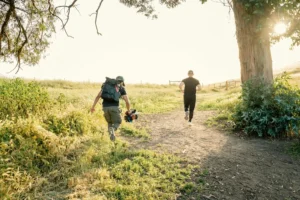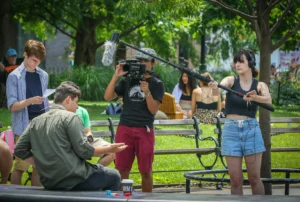What is Run and Gun Filmmaking?

An All-Inclusive Manual for Future Artists.
Run-and-gun filmmaking is a raw, agile, spontaneous technique of production that filmmakers are progressively using in the era of YouTube, TikTok, and independent short films. This approach lets storytellers concentrate on originality, spontaneity, and flexibility over large budgets and sophisticated technology, therefore stripping filmmaking down to its fundamentals.
Congratulations, you have witnessed run and gun filmmaking in action if you have ever watched a behind-the-scenes movie of someone rushing across a city with only a camera and a mic to record a gripping tale.
But just precisely what is it? In what ways does it vary from conventional film? For you, is this appropriate? Let us dissect all of this.
Describe Run and Gun Filmmaking.
Run and gun filmmaking is a fast-paced, guerrilla-style method of filming, stressing little equipment, rapid setups, and natural shooting. Documentary filmmaking, vlogs, vacation videos, event coverage, independent films, and even business material where adaptability is more important than well-planned sequences make regular use of it.
Usually it involves:
- Minimal crew—often only one person—usually
- Manual cameras or gimbals
- Natural illumination is also known as accessible light.
- Not many, if any, permits or site constraints
- Restricted (or non-existent) scripting
- Improvisational guidance
Real events should be promptly and effectively captured without compromising too much on quality.
The Approach of Philosophy Behind It
Run-and-gun filmmaking is a perspective rather than simply a technique.
It roots in flexibility, spontaneity, and efficiency. When you lack time or money for many takes, professional lighting configurations, or location control, the method is perfect. It’s about being creative; typically, intuition and instinct guide one to obtain the photo.
Consider it as photojournalistic but in motion. You are a real-time storyteller, fast-changing, and documenting events as they unfold.
Run and Gun has been used where?
Filming run-throughs with guns is rather flexible. Among the most often used ones are:
- Particularly in erratic settings like demonstrations, conflict zones, or street interviews, documentary shoots
- Many artists film alone using lav microphones and little cameras on YouTube.
- Travel videos: You are always on motion, negotiating shifting light and terrain.
- Weddings, meetings, and live events are covered here.
- Particularly low-budget videos with quick turnarounds in music.
- Corporate and commercial promos: When a customer demands real, behind-the-scenes material right now.
- For certain moments, particularly when time is tight or when trying to get a “real” look, even big productions sometimes use this approach.
Essential Elements of Run and Gun Filmmaking
Usually, a run and a pistol shot consist of this:
- Thin Equipment
Forget dollies, cranes, and large tripods. Usually, a run-and-gun writer works with:
- A DSLR camera or a mirrorless one.
- A microphone, either a shotgun or a lav
- Either a monopod or a gimbal
- Additional SD cards and batteries
- Additional optional: tiny LED light panel
- Velocity Beyond Perfection
Time for many retakes is not available. You have to nail the moment, not improve it.
- Editing On-the-Go
Editing is frequently done similarly rapidly as the film is usually recorded swiftly. Many producers depend on basic cuts, LUTs (Look-Up Tables), and lightweight processes.
- Unintentional Strikes
You may not have a storyboard most of the time. You are writing on demand, selecting perspectives based on gut feeling.
- Not a Crew (or Minimal Crew)
Many run-and-gun directors are one-man bands managing direction, shooting, sound, and sometimes even acting.
Benefits of Run and Gun Filmmaking:
Cost-effective
Huge rents or huge crews are not necessary. Just a camera and a microphone will let you create a whole short film or documentary.
Flexible and Agile
Convert places in minutes. Shoot on your way. Catch unscripted events without prompting action.
Accuracy
The finished work frequently seems genuine, honest, and relevant because it’s so open and natural—a style viewers value more and more.
Perfect for Education
Run and Gun pushes you to learn by doing, think quickly, and make artistic decisions. You have filmmakers on constant alert.
Problems with Run and Gun Filmmaking
This approach has several challenges, even if it is appealing:
Not Predictable Lighting
Natural light varies quickly; without studio lights, you must always be adjusting.
Sound Problems
Carelessness with background noise may spoil takes without a boom mic or sound engineer.
Restricted Authority
No set translates into no control. You are at the will of crowds, traffic, weather, and other real-world elements.
Energy Weariness
Physically and psychologically taxing activities include carrying equipment, moving fast, and multitasking.
Basics for Run and Gun Filmmakers
- One should know their gear.
Get your camera settings under control. Should you be struggling with buttons, you will miss important events.
- Apply autofocus.
Use modern cameras, yet do not rely only on their great focusing mechanisms.
- Catch B- Roll.
Record more video for a shot. Trying to hide jump cuts or mismatched audio can help you thank yourself in post-production.
- Save Backup Energy
Always carry spare memory cards and batteries. A dead camera causes missing events.
- Pre-plan softly.
Although the style is natural, establishing a basic shot list or narrative arc can help you stay focused.
2025 Picks for Best Cameras for Run and Gun Filmmaking
These are the best options for run-and-gun in 2025:
- Great for low light, lightweight, and strong autofocus is the Sony ZV-E1.
- Full-frame quality in a small body is found in the Canon R6 Mark II.
- For independent filmmakers seeking cinematic excellence, the Blackmagic Pocket Cinema Camera 6K is the best.
- Excellent picture quality and in-body stabilization define the Fujifilm X-S20.
- GoPro Hero 12 is perfect for adventure-style, high-action photos.
Run and Gun Filmmaking: Who Should Try?
If your situation is:
- A content producer working on a budget
- A producer of documentaries
- A single vlogger or tourist.
- A novice looking for practical experience.
- One who enjoys spontaneity
Without the safety net of big teams or equipment, it teaches you to concentrate on the narrative, accept flaws, and understand the nuts and bolts of visual storytelling.
Conclusion
Not everyone can run and gun a film. It may not be your cup of tea if you want exact planning, complete lighting configurations, and big teams. This approach is very freeing, however, for those who like to record events as they happen and thrive in hectic settings.
The run-and-shoot approach is not only useful but also potent in the content-saturated environment of today, when authenticity rules over perfection.
So pick up your camera, tap record, and start sprinting.

FAQs About Run and Gun Filmmaking:
1. Is this exclusively for novices?
Hardly at all. Although this is a basic technique, even experts utilize it for time-sensitive assignments, vacation shots, and documentaries. This is a method rather than a skill level.
2. Does starting with pricey hardware make sense?
Not yes. Many of them start with only a laptop mic and a smartphone. Gear is secondary as long as you give narrative and framing top priority.
3. How do I handle inadequate lighting?
Make imaginative use of natural light. Set your subject close to windows, take pictures during golden hour, or pack a tiny LED panel for a last-ditch.
4. For run-and-Gun, what audio gear is best?
Ideals are either wireless lavaliers (like DJI Mic or Rode Wireless GO) or shotgun microphones (like Rode VideoMic series). Often, audio quality either makes or ruins your video.
5. Can run-and-gun methods be used in professional filmmaking?
Totally. This method is used in many award-winning documentaries and short films. Solid editing and narrative will enable you to create broadcast-quality material.